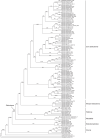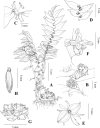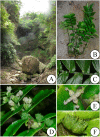Elatostema qinzhouense (Urticaceae), a new species from limestone karst in Guangxi, China
- PMID: 33976965
- PMCID: PMC8061576
- DOI: 10.7717/peerj.11148
Elatostema qinzhouense (Urticaceae), a new species from limestone karst in Guangxi, China
Abstract
Elatostema qinzhouense L.F. Fu, A.K. Monro & Y.G. Wei, a new species from Guangxi, China is described and illustrated. Morphologically, E. qinzhouense is most similar to E. hezhouense from which it differs by having smaller size of leaf laminae, fewer and smaller staminate peduncle bracts, longer pistillate peduncle bracts and a larger achene. This result is supported by the molecular evidence. The phylogenetic position of the new species within Elatostema is evaluated using three DNA regions, ITS, trnH-psbA and psbM-trnD, for 107 taxa of Elatostema s.l. (including E. qinzhouense). Bayesian inference (BI) and maximum likelihood (ML) analyses each recovered the same strongly supported tree topologies, indicating that E. qinzhouense is a member of the core Elatostema clade and sister to E. hezhouense. Along with the phylogenetic studies, plastid genome and ribosomal DNA (rDNA) sequences of the new species are assembled and annotated. The plastid genome is 150,398 bp in length and comprises two inverted repeats (IRs) of 24,688 bp separated by a large single-copy of 83,919 bp and a small single-copy of 17,103 bp. A total of 113 functional genes are recovered, comprising 79 protein-coding genes, 30 tRNA genes, and four rRNA genes. The rDNA is 5,804 bp in length and comprised the 18S ribosomal RNA partial sequence (1,809 bp), internal transcribed spacer 1 (213 bp), 5.8S ribosomal RNA (164 bp), internal transcribed spacer 2 (248 bp) and 26S ribosomal RNA partial sequence (3,370 bp). In addition, the chromosome number of E. qinzhouense is observed to be 2n = 26, suggesting that the species is diploid. Given a consistent relationship between ploidy level and reproductive system in Elatostema, the new species is also considered to be sexually reproducing. Our assessment of the extinction threat for E. qinzhouense is that it is Endangered (EN) according to the criteria of the International Union for Conservation of Nature.
Keywords: Karst; Karyotype; Phylogeny; Plastid genome; Reproductive system; Taxonomy.
©2021 Fu et al.
Conflict of interest statement
The authors declare there are no competing interests.
Figures





References
-
- Bachman S, Moat J, Hill AW, De la Torre J, Scott B. Smith V, Penev L, editors. Supporting Red List threat assessments with GeoCATAT: geospatial conservation assessment tool. http://geocat.kew.org/ [10 December 2018];e-Infrastructures for data publishing in biodiversity science. ZooKeys. 150: 117–126, and GeoCATAT. Geospatial Conservation Assessment Tool. [Online] 2011
-
- Chase MW, Hills H. Silica gel: an ideal material for field preservation of leaf samples for DNA studies. Taxon. 1991;40(2):215–220. doi: 10.2307/1222975. - DOI
-
- Chen LY, Song MS, Zha HG, Li ZM. A modified protocol for plant genome DNA extraction. Plant Diversity and Resources. 2014;36:375–380. doi: 10.7677/ynzwyj201413156. - DOI
-
- Fu LF, Do VT, Wen F, He CX. Elatostema arcuatobracteatum (Urticaceae), a new species from Vietnam. Phytotaxa. 2014;174:111–115. doi: 10.11646/phytotaxa.174.2.6. - DOI
-
- Fu LF, Monro A, Do VT, Nuraliev MS, Averyanov LV, Wen F, Xin ZB, Maisak TV, Kuznetsov AN, Kuznetsova SP, Nguyen KS, Wei YG. Checklist to the Elatostema (Urticaceae) of Vietnam including 19 new records, ten new combinations, two new names and four new synonyms. PeerJ. 2019a;6:e6188. doi: 10.7717/peerj.6188. - DOI - PMC - PubMed
LinkOut - more resources
Full Text Sources
Other Literature Sources
Research Materials

